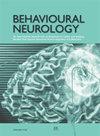The Application Effect of Craniotomy through Transsylvian Rolandic Point-Insular Approach on Hypertensive Intracerebral Hemorrhage in Posterior Basal Ganglia
IF 2.7
4区 医学
Q2 CLINICAL NEUROLOGY
引用次数: 0
Abstract
Objective. To evaluate the hematoma clearance and safety of small bone window craniotomy through the lateral fissure Rolandic point-insular lobe approach for patients with hypertensive intracerebral hemorrhage (HICH) in posterior basal ganglia. Methods. This retrospective study enrolled a total of 86 patients with HICH in the posterior basal ganglia region who underwent surgery between January 2020 and December 2021. These patients were divided into two groups: the conventional group and the study group. The intraoperative information, postoperative hematoma clearance rate, increasing rate of cerebral edema and rebleeding occurrence rate, postoperative complication rate, and prognoses were compared between the two groups. Additionally, we observed and compared the rate of postoperative cerebral hematoma increase, as well as the neurological function and activities of daily living (ADL) at admission, 3 months, and 6 months after surgery in both groups. Univariate and multivariate logistic regression analyses were performed to explore factors affecting the prognosis of patients with HICH in the posterior basal ganglia region after small bone window craniotomy through the lateral fissure Rolandic point-insular lobe approach. Results. The study group exhibited significantly shorter automatic eye-opening times and hospital stays compared to the conventional group (). Furthermore, the study group demonstrated better hematoma clearance rates, lower rates of cerebral hematoma at postoperative 48 h and 72 h, and lower rates of rebleeding compared to the conventional group (). At 3 and 6 months postsurgery, the study group exhibited a significantly greater improvement in neurological function and ADL compared to the conventional group (). Additionally, the incidence of postoperative complications in the study group was lower than that in the conventional group (). Furthermore, the prognosis of the study group was significantly better than that of the conventional group at the 6-month follow-up (). Conclusion. A small bone window craniotomy via transsylvian Rolandic point-insular approach has been shown to improve the hematoma clearance rate in patients with HICH in the posterior basal ganglia region while also reducing the incidence of complications. This approach is highly safe and feasible for implementation in clinical practice.特兰西维亚罗兰点岛入路开颅术在基底节区后脑出血中的应用效果
目标。目的探讨经外侧裂罗兰点岛叶入路小骨窗开颅治疗后基底节区高血压脑出血的血肿清除率及安全性。方法。这项回顾性研究共招募了86名在2020年1月至2021年12月期间接受手术治疗的后基底节区HICH患者。这些患者被分为两组:常规组和研究组。比较两组患者术中资料、术后血肿清除率、脑水肿加重率及再出血发生率、术后并发症发生率及预后。此外,我们观察并比较两组患者入院时、术后3个月、6个月时脑血肿增加率、神经功能和日常生活活动(ADL)。采用单因素和多因素logistic回归分析探讨经外侧裂rolanddic点-岛叶入路小骨窗开颅后基底节区高脑出血患者预后的影响因素。结果。与常规组相比,研究组的自动睁眼时间和住院时间明显缩短()。此外,与常规组相比,研究组血肿清除率更高,术后48 h和72 h脑血肿率更低,再出血率更低()。术后3个月和6个月,与常规组相比,研究组在神经功能和ADL方面表现出更大的改善()。此外,研究组术后并发症发生率低于常规组()。随访6个月时,研究组预后明显优于常规组()。结论。经经西半球Rolandic点岛入路的小骨窗开颅术已被证明可以提高基底节后区高脑出血患者的血肿清除率,同时也减少了并发症的发生率。该方法在临床实践中具有较高的安全性和可行性。
本文章由计算机程序翻译,如有差异,请以英文原文为准。
求助全文
约1分钟内获得全文
求助全文
来源期刊

Behavioural Neurology
医学-临床神经学
CiteScore
5.40
自引率
3.60%
发文量
52
审稿时长
>12 weeks
期刊介绍:
Behavioural Neurology is a peer-reviewed, Open Access journal which publishes original research articles, review articles and clinical studies based on various diseases and syndromes in behavioural neurology. The aim of the journal is to provide a platform for researchers and clinicians working in various fields of neurology including cognitive neuroscience, neuropsychology and neuropsychiatry.
Topics of interest include:
ADHD
Aphasia
Autism
Alzheimer’s Disease
Behavioural Disorders
Dementia
Epilepsy
Multiple Sclerosis
Parkinson’s Disease
Psychosis
Stroke
Traumatic brain injury.
 求助内容:
求助内容: 应助结果提醒方式:
应助结果提醒方式:


